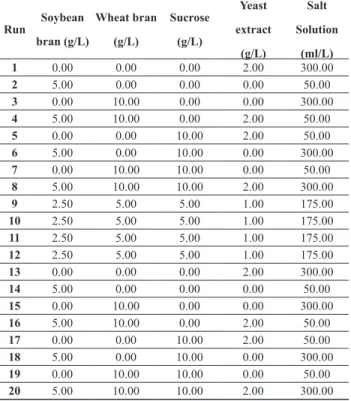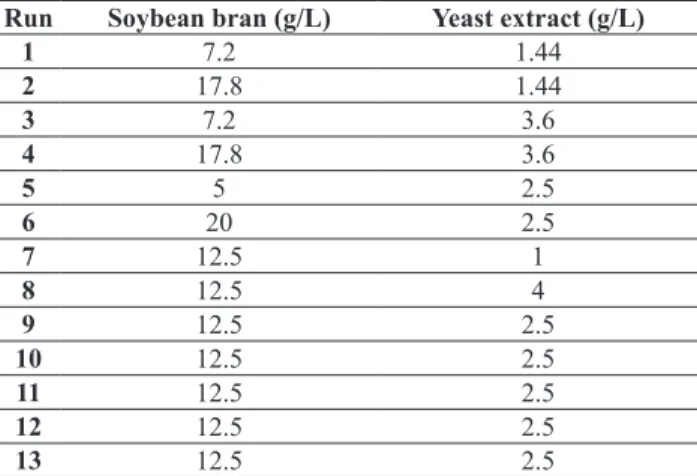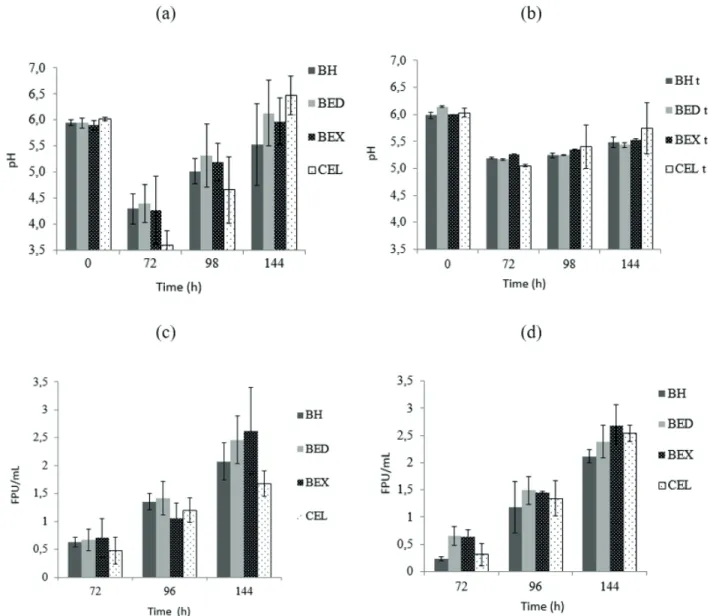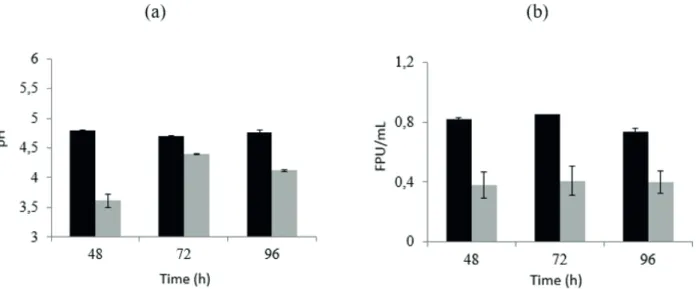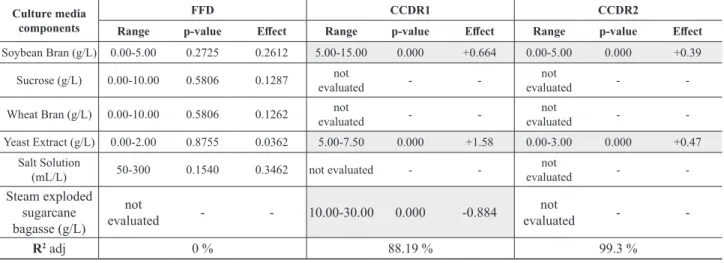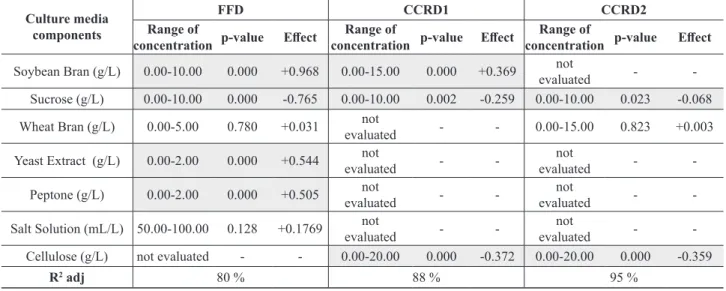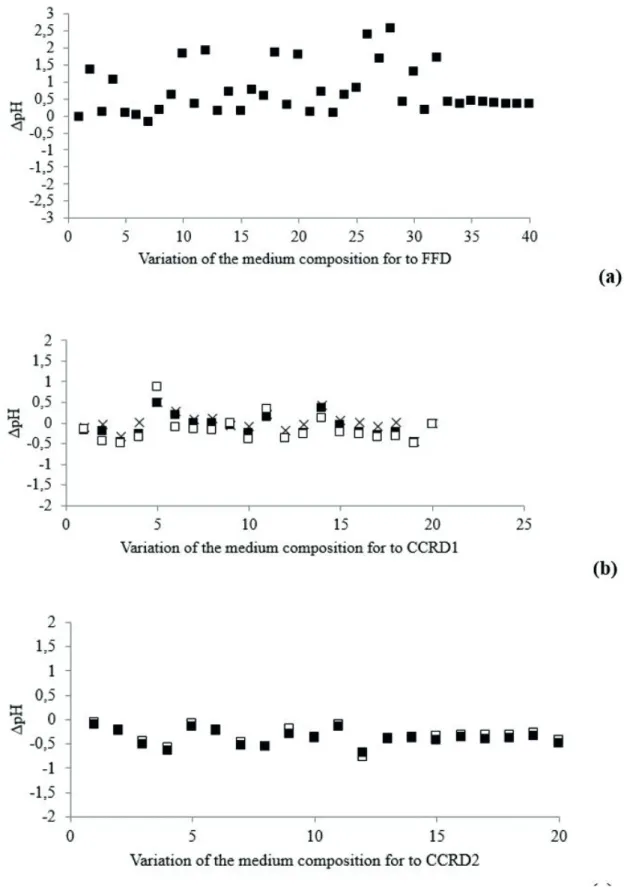of Chemical
Engineering
www.abeq.org.br/bjchePrinted in BrazilVol. 34, No. 02, pp. 439 - 450, April - June, 2017 dx.doi.org/10.1590/0104-6632.20170342s20150522
POTASSIUM BIPHTHALATE BUFFER FOR pH
CONTROL TO OPTIMIZE GLYCOSYL HYDROLASE
PRODUCTION IN SHAKE FLASKS USING
FILAMENTOUS FUNGI
P. dos S. Costa
1,2*, D. Robl
1,3, I. C. Costa
1, D. J. da S. Lima
1,
A. C. Costa
2and J. G. da C. Pradella
11Brazilian Bioethanol Science and Technology Laboratory (CTBE), Brazilian Centre of Research in Energy and Materials (CNPEM), Rua Giuseppe Maximo Scolfaro 10000, Pólo II de Alta Tecnologia, CEP 13083-970, Campinas, São Paulo, Brazil.
2School of Chemical Engineering, State University of Campinas, Campinas, São Paulo, Brazil.
Tel.: +55 19 3518 3149; Fax: +55 19 3518 3104 E-mail address: patriciacosta.ufv@gmail.br 3Institute of Biomedical Sciences, University of São Paulo,
São Paulo, Brazil.
(Submitted: August 20, 2015; Revised:January 21, 2016; Accepted: February 26, 2016)
Abstract – The optimization of culture medium with statistical methods is widely used in ilamentous fungi glycosyl hydrolase production. The implementation of such methodology in bioreactors is very expensive as it requires several pH-controlled systems operating in parallel in order to test a large number of culture media components. The objective of this study was to evaluate potassium biphthalate bufer for pH control, which allows the optimization studies to be performed in shake lasks.The results have shown that bufering the culture medium with 0.1 M potassium biphthalate allowed pH control, resulting in a decrease of the standard deviation of triplicates for pH and activities of glycosyl hydrolase measurements. The use of this bufer allowed shake lask culture media optimization of enzyme production by Trichoderma harzianum, increasing the cellulase activity by more than 2 times compared to standard unbufered culture medium. The same bufer can be used for culture media optimization of other fungi, such as Penicillium echinulatum.
Keywords: Potassium biphthalate bufer; pH control; enzyme production; glycosyl hydrolase; ilamentous fungi.
INTRODUCTION
Cellulosic ethanol has been gaining increasing attention as an environmentally friendly biofuel with potential to compete with gasoline. Nevertheless, production costs are still prohibitive and the main costs are related to enzyme production and enzymatic hydrolysis of lignocellulosic material. The latter relies on the use of a plethora of glycosyl hydrolase enzyme complexes, which are mainly composed of cellobiohydrolase, endoglucanases and β-glucosidases in addition to a diversity of hemicellulases
and other accessory proteins that help unlock the ligocellulosic complex arrangement (Berlin et al. 2005; Kumar et al. 2009). Cellulolytic ilamentous fungi
Culture media and bioreactor process optimization (Delabona et al., 2013a; Delabona et al., 2013b; dos Reis et al., 2013; Pereira et al., 2013), as well as genetic improvements of these ilamentous fungi (Dillon et al., 2006), have been studied to decrease production costs.
Culture medium optimization by statistical methodologies is of great interest for ilamentous fungi glucosyl hydrolase improvement (Delabona et al., 2013; Li et al., 2007). However, this methodology requires a great number of experiments and its implementation in bioreactors is very expensive and the shake lask submerged cultivation method is an attractive choice to access this information. It is known that the best pH for induction of cellulase for
P. echinulatum S1M29 biosynthesis in a bioreactor is from 5.5 to 6.5 (dos Reis et al., 2014), while a pH from 5.0 to 6.0 is the best for cellulase induction for T. harzianum
P1P49 in bioreactor cultivation (Delabona et al. 2012). On the other hand, the type and the concentration of culture media ingredients afect the pH during fermentation and it is diicult to predict pH luctuations. In the case of high-throughput screening experiments carried out in shake lasks this fact may lead to inconclusive results as pH inluences enzyme production. Therefore, an adequate control of this parameter during fungal submerged cultivation in shaking lasks is of paramount importance.
Potassium biphthalate bufer has a set of interesting physico-chemical properties that turns it into a potential candidate to stabilize the pH during microorganism growth. It covers a large range of pH in the proper range for cellulase production by fungus (3.4 to 5.9); it is not consumed, unlike citrate bufers; and it is physiologically compatible with ilamentous fungi (Domingues et al., 2000; Ferreira et al., 2009).
The present work describes the utilization of potassium biphtalate bufers in shake lask cultivation of
P. echinulatum and T. harzianum grown in complex culture media components (sugarcane bagasse submitted to diferent pre-treatments, cellulose, sucrose, soybean bran, wheat bran and yeast extract). The use of this methodology led to shake lask culture media optimization of enzyme production by Trichoderma harzianum, increasing the cellulase activity by more than 2 times compared to standard unbufered culture medium. The same bufer can also be used for culture media optimization of P. echinulatum.
MATERIALS AND METHODS
Microorganism
The ilamentous fungus Trichoderma harzianum
P49P11, isolated in the Amazon Rainforest (Delabona et al., 2012), was obtained from Embrapa Instrumentation - São Carlos, SP, deposited in the collection of microorganisms of Embrapa Food Technology (Rio de Janeiro, Brazil), access number BRMCTAA115. The ilamentous fungus
Penicillium echinulatum S1M29 is a mutant (Dillon et al., 2011) provided by the University of Caxias do Sul, RS, Brazil. Microorganisms used were stored in glycerol solution (30 % v/v) at - 80 °C.
Submerged fermentation
All submerged fermentation experiments were conducted in a shaker using a 500 mL erlenmeyer lask containing 200 mL of the culture media at 200 rpm (Inova 44R, New Brunswick Scientiic, USA) and incubated at 29°C as suggested by Pereira et al. (2013) and Machado et al. (2012) for P. echinulatum and Delabona et al. (2012, 2013a, 2013b) for T. harzianum.
The ilamentous fungi were grown on PDA plates at 29 °C for 7 days. The spores were harvested with 20 mL of Tween 80 solution (0.1 % v/v) and transferred to a pre-inoculum medium composed of Celuloc 200TM
(CEL) (Celulok Ind Com, Brazil) 10 g/L, glucose (GL) 10 g/L, peptone (PEP) 1 g/L, salt solution (Mandels & Reese, 1957) (SS) 100 mL/L and Tween 80 1 mL/L.The pre-inoculum was kept at 29 °C, 200 rpm for 72 hours. A volume of 20 mL of this pre-inoculum was transferred to a 500 mL Erlenmeyer lask containing 200 mL of
culture media with composition varying according to the experimental design with and without potassium biphthalate bufer at pH 5.0 or 5.9, according to the studied conditions, and incubated in the same conditions described above. Experiments were designed and analysed using the DOE (Design of Experiments) package from STATISTICA 7.0 (Statsoft, USA). Mathematical modelling optimization used the backward elimination technique (Neto et al., 2010; Rodrigues & Iemma, 2005) and the embeded subroutine SOLVER (Excel 2013; Microsoft Inc. USA).
Bufer efect on enzymatic activity in diferent inductor carbon sources
Experiments were carried out in order to test the inluence of potassium biphthalate bufer in fungal cultivation with diferent inductor carbon sources of glycosyl hydrolase measured as cellulase activity.
The inluence of potassium biphtalate bufer was investigated for P. echinulatum S1M29 using diferent
pretreated sugarcane bagasse at 10 g/L: steam exploded sugarcane bagasse (BEX), steam exploded sugarcane bagasse followed by hot NaOH deligniication (BED), hydrothermal pretreated sugarcane bagasse (BH), and commercial micropulverized cellulose Celuloc200TM
The inluence of potassium biphthalate bufer on the cellulase activity was investigated for T. harzianum
P49P11 in a culture medium composed of deligniied steam exploded sugarcane bagasse (BED) 7 g/L, sucrose (SUC) 3 g/L, ammonium sulfate (SM) 1.4 g/L, peptone (PEP) 1 g/L, Tween 80 1 mL/L and salt solution (SS) 100 mL/L (dos Reis et al., 2013). These experiments were also performed both in the presence and the absence of potassium biphthalate bufer (0.1M) pH 5.0.
All the experiments were run in triplicate and results were presented as mean and standard deviation.
Experimental design
The experiments aimed to analyze the inluence of potassium biphthalate bufer on pH control during the culture media optimization experiments using shake lasks, and pointed out the possible inluence of these components on the pH variation.
Three experimental designs were carried out with P. echinulatum PS1M29 fungus: one Fractional Factorial Design (25-1) (FFD) and two Central Composite
Rotational Designs, CCRD1 and CCRD2. The FFD (2 5-1) was performed in order to study ive culture medium
components (concentration range in parenthesis); SB (0-5 g/L), WB (0-10 g/L), YE (0-2 g/L), SUC (0-10 g/L) and salt solution SS (50-300 mL/L). The CCRD1 used high substrate concentrations of SB (5-15 g/L), YE (5-7.5 g/L) and BEX (10-30 g/L). The initial pH was set up at 5.9 using 0.1 M of potassium biphthalate bufer. The CCRD2 was performed by testing diferent amounts of SB (0-5 g/L) and YE (0-3 g/L) at initial pH 4.7 using 0.1 M biphthalate bufer. The culture media composition and the run number used in these DOE are displayed in Tables 1, 2 and 3.
Three statistical designs were carried out with T. harzianum P49P11 fungus: one Fractional Factorial Desing FFD (26-1) and two Central Composite Rotational
Desings CCRD1 and CCRD2. The FFD (26-1) evaluated
the inluence of components SB (0-10 g/L), WB (0-5 g/L), SUC (0-10 g/L), YE (0-2 g/L), PEP (0-2 g/L) and SS (50-100 mL/L) on pH luctuation. The CCR1 studied culture media composed of SUC (0-10 g/L), CEL (0-20 g/L) and SM (0-15 g/L), while the CCR2 studied culture media composed of SUC 10 g/L), CEL 20 g/L) and WB (0-15 g/L).
The culture media composition and the run number used in these DOE are displayed in Tables 4 and 5.
When not studied as above described other culture media components were ixed as follows: Celuloc (CEL) 10 g/L; ammonium sulfate (SM) 1.4 g/L, peptone (PEP) 1 g/L, Tween 80 1 mL/L and salt solution (SS) 100 mL.
For all the experimental designs, samples were collected at diferent fermentation times, centrifuged at 10.000 ×g for 10 minutes at 10 °C and the supernatants had their pH measured. Activities were determined and the
point of maximum activity was used as the response of the experimental design. Standard errors were calculated using central point replicates, as designed by the DOE package of Statistica 7.0.
Table 1. Culture media composition for P. echinulatum
S1M29, FFD 25-1experiments.
Run Soybean bran (g/L) Wheat bran (g/L) Sucrose (g/L) Yeast extract (g/L) Salt Solution (ml/L)
1 0.00 0.00 0.00 2.00 300.00
2 5.00 0.00 0.00 0.00 50.00
3 0.00 10.00 0.00 0.00 300.00
4 5.00 10.00 0.00 2.00 50.00
5 0.00 0.00 10.00 2.00 50.00
6 5.00 0.00 10.00 0.00 300.00
7 0.00 10.00 10.00 0.00 50.00
8 5.00 10.00 10.00 2.00 300.00
9 2.50 5.00 5.00 1.00 175.00
10 2.50 5.00 5.00 1.00 175.00
11 2.50 5.00 5.00 1.00 175.00
12 2.50 5.00 5.00 1.00 175.00
13 0.00 0.00 0.00 2.00 300.00
14 5.00 0.00 0.00 0.00 50.00
15 0.00 10.00 0.00 0.00 300.00
16 5.00 10.00 0.00 2.00 50.00
17 0.00 0.00 10.00 2.00 50.00
18 5.00 0.00 10.00 0.00 300.00
19 0.00 10.00 10.00 0.00 50.00
20 5.00 10.00 10.00 2.00 300.00
Table 2. Culture media composition for P. echinulatum
S1M29, CCRD1experiments.
Run Soybean bran (g/L) Yeast extract (g/L) Steam exploded sugarcane bagasse (g/L)
1 5 5 10
2 15 5 10
3 5 7.5 10
4 15 7.5 10
5 5 5 30
6 15 5 30
7 5 7.5 30
8 15 7.5 30
9 1.6 6.25 20
10 18.4 6.25 20
11 10 4.14 20
12 10 8.35 20
13 10 6.25 3.2
14 10 6.25 36.8
15 10 6.25 20
16 10 6.25 20
17 10 6.25 20
18 10 6.25 20
19 10 6.25 20
Table 3. Culture media composition for P. echinulatum S1M29, CCRD2experiments.
Run Soybean bran (g/L) Yeast extract (g/L)
1 7.2 1.44
2 17.8 1.44
3 7.2 3.6
4 17.8 3.6
5 5 2.5
6 20 2.5
7 12.5 1
8 12.5 4
9 12.5 2.5
10 12.5 2.5
11 12.5 2.5
12 12.5 2.5
13 12.5 2.5
Table 4. Culture media composition for T. harzianum P49P11, FDD 26-1 experiments.
Run Soybean bran (g/L) Wheat bran (g/L) Sucrose (g/L) Yeast extract (g/L) Peptone (g/L) Salt solution (mL/L)
1 0 0 0 0 0 50
2 10 0 0 0 0 100
3 0 5 0 0 0 100
4 10 5 0 0 0 50
5 0 0 10 0 0 100
6 10 0 10 0 0 50
7 0 5 10 0 0 50
8 10 5 10 0 0 100
9 0 0 0 2 0 100
10 10 0 0 2 0 50
11 0 5 0 2 0 50
12 10 5 0 2 0 100
13 0 0 10 2 0 50
14 10 0 10 2 0 100
15 0 5 10 2 0 100
16 10 5 10 2 0 50
17 0 0 0 0 2 100
18 10 0 0 0 2 50
19 0 5 0 0 2 50
20 10 5 0 0 2 100
21 0 0 10 0 2 50
22 10 0 10 0 2 100
23 0 5 10 0 2 100
24 10 5 10 0 2 50
25 0 0 0 2 2 50
26 10 0 0 2 2 100
27 0 5 0 2 2 100
28 10 5 0 2 2 50
29 0 0 10 2 2 100
30 10 0 10 2 2 50
31 0 5 10 2 2 50
32 10 5 10 2 2 100
33 5 2.5 5 1 1 75
34 5 2.5 5 1 1 75
35 5 2.5 5 1 1 75
Run Soybean bran (g/L) Wheat bran (g/L) Sucrose (g/L) Yeast extract (g/L) Peptone (g/L) Salt solution (mL/L)
36 5 2.5 5 1 1 75
37 5 2.5 5 1 1 75
38 5 2.5 5 1 1 75
39 5 2.5 5 1 1 75
40 5 2.5 5 1 1 75
Table 4. Cont.
Table 5. Culture media compositions for CCRD1 (using Soybean Bran) and CCRD2 (using Wheat Bran) experiments for
TrichidermaharzianumP49P11. Run Sucrose (g/L) Celuloc (g/L) Soybean Bran (g/L) Wheat bran (g/L)
1 2.02 4.05 3.04 3.04
2 7.97 4.05 3.04 3.04
3 2.02 15.94 3.04 3.04
4 7.97 15.94 3.04 3.04
5 2.02 4.05 11.95 11.95
6 7.97 4.05 11.95 11.95
7 2.02 15.94 11.95 11.95
8 7.97 15.94 11.95 11.95
9 0.00 10.00 7.50 7.50
10 10.00 10.00 7.50 7.50
11 5.00 0.00 7.50 7.50
12 5.00 20.00 7.50 7.50
13 5.00 10.00 0.00 0.00
14 5.00 10.00 15.00 15.00
15 5.00 10.00 7.50 7.50
16 5.00 10.00 7.50 7.50
17 5.00 10.00 7.50 7.50
18 5.00 10.00 7.50 7.50
In all the experiments pH levels were measured using a pH probe and standard potentiometer (Mettler Toledo S220 model) and pH variation was calculated as the diference between the initial and inal pH values. Supernatant cellulase activity was measured using the Filter Paper method with a reduction scale of 10 times (Ghose, 1987), from now on expressed as FPase activity and reported as FPU/mL. Reducing carbohydrate was measured by the DNS method (Miller, 1959), using glucose as a standard.
Schematic representation of the obtained results
RESULTS AND DISCUSSION
Bufer efect on pH variation and cellulase production using diferent inductor carbon sources
Sugarcane bagasse pretreated by diferent methods (BEX, BED and BH) or standard micronized commercial cellulose Celuloc (CEL) were used for P. echinulatum
S1M29 and T. harzianum P11P49 as the glucosyl hydrolase inductor carbon source in shake lask experiments. The objective was to evaluate the inluence of potassium biphthalate bufer (pH 4.7 to 5.9) on the FPase enzyme activity and culture broth pH variation over time.
Submerged fermentation experiments with P. echinulatum were run both in unbufered and bufered
condititions. The latter was conducted with a potassium biphatalate bufer at initial pH 5.9, known to be the optimum pH range for cellulase biosynthesis (dos Reis et al., 2014). The unbufered assays displayed a large pH luctuation over time for all tested carbon sources, decreasing from ~5.9 to 3.5 and returning to ~5.9 at the 144 h of fermentation (Fig 2a). On the other hand, bufered experiments decreased the pH luctuation (Fig 2b) for all the tested carbon sources, with pH varying from ~ 6.0 to 5.0 in the irst 72h and then rising to ~ 5.7 at the end of the experiment. Therefore, the use of biphthalate bufer accomplished its function to stabilize the pH in shake lasks cultivation and did not jeopardize the enzyme production in the tested conditions.
A previous study on the efect of various inductor sources carried out with T. hazrzianum P49P11 in controlled bioreactors demonstrated that deligniied steam exploded bagasse (BED) was, among the tested sources, the most
convenient for cellulase on-site production (Delabona et al. 2012), so experiments with bagasse submitted to the other pretreatments were not performed in the present work.
Cellulase production by T. harzianum P49P11using BED as inductor at pH 5.0 was quite diferent in bufered and unbufered condition (Fig 3a and 3b). Stabilization of pH luctuation over time was observed with the use of biphtalate bufer, with the pH maintained around 5.0, while the culture broth pH dropped to 3.5 in unbufered conditions (Fig 3a). The maximum FPase activity attained 0.8 ± 0.02 FPU/mL from 72h to 96h when potassium biphthalate was used, while for the unbufered culture this value never exceeded 0.4 ± 0.13 FPU/mL (Fig 3b). Clearly, a pH below 4.0 impaired glycosyl hydrolase biosynthesis in the latter experiments. This endorses the results of Delabona et al. (2012), who claimed that a pH range from 5.0 to 6.0 would enhance T. harziamum P1P49 FPase titers. Besides, the experiments carried out with P. echinulatum and T. harzianum demonstrated the eiciency of the proposed
bufer system and corroborated the results of Ferreira et al. (2009), who irst proposed the use of potassium biphtalate bufer in submerged shake lask cellulase production by T. reesei.
Culture medium components inluence pH luctuation
Figure 2: Time evolution of pH and FPase titer for Penicillium echinulatum S01M29 submerged cultivation in diferent carbon sources.
(a) without pH control. (b) pH controlled by 0.1M potassium biphthalate. (c) FPase without pH control. (d) FPase controlled at pH 5.9
with 0.1 M potassium biphthalate bufer. Values of triplicates with their respective standard deviation.
to evaluate the potassium biphtalate bufer eiciency for pH control in shake lask cultivation experiments, several DOE were set up for the ilamentous fungi P. echinulatum
and T. harzianum. The culture media ingredients were selected based on previous glycosyl hydrolase production studies using P. echinulatum (Pereira et al., 2013) and T. harzianum (Delabona et al., 2013b).
P. echinulatum S1M29 case
Three sets of experiments were carried using P. echinulatum S1M29 with the potassium biphtalate bufer:
a Fractional Factorial Design (FFD), which was set up to study the inluence of ive diferent culture media components, and two Central Composite Rotational
Designs (CCRD1 and CCRD2) using a reduced number of culture media components, SB (soybean bran), YE (yeast extract) and BEX (deligniied steam exploded sugarcane bagasse).
The assigned number of the run and the corresponding culture media compositions for the FFD, CCRD1 and CCRD2 are presented respectively in Tables 1 to 3. Figure 4 shows the values of ∆pH (∆pH = inal pH-intial pH) observed for the three sets of experiments. In Figure 4 the x
axis stands for the number of the run presented in Tables 1 to 3. The statistical main efects of the considered medium components on ∆pH are summarized in Table 6.
Figure 3: Time evolution of pH and FPase titer for Trichoderma harzianum P49P11 S01M29 submerged cultivation in culture
medium, according to Delabona et al. 2013. (a) FPase in controlled pH 5.0 by 0.1 M potassium biphthalate bufer (black bar) FPase in uncontrolled pH (grey bar). (b) pH controlled by 0.1 M potassium biphthalate bufer (black bars) and without pH control (grey bar).
Values of triplicates with their respective standard deviation.
the tested culture media components (Table 6). Figure 4a shows that pH luctuation during cultivation was in the range of ± 1.0 around the initial value of 5.9. It was previously shown that the highest glycosyl hydrolase production was observed at pHs around 6.0 (dos Reis et al., 2014). Therefore, the potassium biphtalate bufer used was very eicient in maintaining pH at the optimum value for
P. echinulatum glycosyl hydrolase biosynthesis, enabling the optimization studies for glycosyl hydrolase production to be performed in shake lasks.
To explore the possibility of the use of this methodology in a less mild environment, CCRD1 was run at much higher concentrations of soybean lour (SB) (5-15 g/L), yeast extract (YE) (5-7.5 g/L) and steam exploded bagasse (BEX) (10-30 g/L) (Table 2). In this circumstance, despite the use of potassium biphtalate bufer, the ∆pH variation was larger than ±1.0 and pH values as high as 8.5 were observed (Fig 4b). Efects analysis indicates that these values were probably due to high concentrations of SB and YE (Table 6). The BEX contribution was statistically signiicant to decrease culture broth pH. Mathematical modeling to study the inluence of culture media on cellulase production was therefore not possible in shake lasks as the biphthalate bufer was not eicient to attain culture broth pH control.
To avoid this efect, CCRD2 experiments were run with lower SB and YE concentration levels, respectively 0-3 g/L and 0-5 g/L, maintaining the BEX concentration at 20 g/L. It was also anticipated that NH4+ secretion due
to metabolism of SB and YE would increase the culture broth pH. To minimize this problem the initial pH values for the experiments with potassium biphthalate bufer were diminished to 4.7. Soybean bran and yeast extract increased
the culture broth pH (Table 6), but a low pH variation was observed (Figure 4c).
Therefore, it was possible to maintain ∆pHs within quite a low range, which enabled us to carry out mathematical modeling studies to attain culture media optimization for glycosyl hydrolase production in shake lasks using the potassium biphtalate bufer.
T. harzianum P49P11 case
Three sets of experiments were performed with T. harzianum P49P11 using potassium biphtalate bufer: one
Fractional Factorial Design (FFD) to verify the inluence of ive diferent culture media components, and two Central Composite Rotational Designs (CCRD1 and CCDR2) using a reduced number of culture media components.
The assigned number of the run and the corresponding culture media compositions for the FFD, CCRD1 and CCRD2 are presented respectively in Tables 4 and 5. Figure 5 shows the values of ∆pH (∆pH = inal pH-intial pH) observed for the three sets of experiments. The Figure 5 x axis stands for the number of the run presented in Tables 4 to 5. The main statistical efects of the considered medium components on ∆pH are summarized in Table 7.
Results from Table 7 show that in fact almost all the tested culture media components (except salt solution -SS, and wheat bran -WB) inluenced the pH variation at the 95 % conidence level for all the DOEs carried out, demonstrating the high sensitivity of T. harzianum culture medium formulation to pH adjustment even with the use of the the proposed bufer.
Culture media components
FFD CCDR1 CCDR2
Range p-value Efect Range p-value Efect Range p-value Efect
Soybean Bran (g/L) 0.00-5.00 0.2725 0.2612 5.00-15.00 0.000 +0.664 0.00-5.00 0.000 +0.39
Sucrose (g/L) 0.00-10.00 0.5806 0.1287 not
evaluated -
-not
evaluated -
-Wheat Bran (g/L) 0.00-10.00 0.5806 0.1262 not
evaluated -
-not
evaluated -
-Yeast Extract (g/L) 0.00-2.00 0.8755 0.0362 5.00-7.50 0.000 +1.58 0.00-3.00 0.000 +0.47
Salt Solution
(mL/L) 50-300 0.1540 0.3462 not evaluated -
-not
evaluated -
-Steam exploded sugarcane bagasse (g/L)
not
evaluated - - 10.00-30.00 0.000 -0.884
not
evaluated -
-R2 adj 0 % 88.19 % 99.3 %
Figure 4: ∆pH for the diferent compositions of culture medium for Penicillium echinulatum S01M29 in submerged fermentation at 144 h (a) CCRD1 cultivation using potassium biphthalate bufer 0.1 M pH 5.9. (b) CCRD2 cultivation using potassium biphthalate bufer 0.1 M pH 4.7. (c) FFD cultivation using potassium biphthalate bufer 0.1 M pH 5.9. Table 6. Main efects of culture medium components in the diferent DOE on pH variation (ΔpH = inal pH - initial pH) in shake
lasks Penicillium echinulatum S1M29 cultivation. The initial pH was 5.9 for the FFD and CCDR1 experiments, and 4.7 for CCRD2
culture at the 95 % conidence level, with p-values of ca.
0.000 for the three organic nitrogen sources, probably due to NH4+ acccumulation in the culture broth during
assimilation of these components.
On the other hand, sucrose strongly decreased the pH of the culture medium at the 95 % conidence level for all DOEs carried out (p-value ca. 0.000, Table 7). This suggested an incomplete carbohydrate catabolism and probably an accumulation of carboxylic acids in the culture broth.
It was previously observed for T. harzianum P49P11 that pH variation within the range of ± 1.0 in the broth did not afect the activity of glycohydrolases if the pH was within the range of 5.0 to 6.0 (Delabona et al., 2013b). It can be observed from Table 7 and Figure 5a that the ∆pH values in the FFD were about 2.0 units greater than allowed, therefore invalidating the possibility of mathematical modeling studies for enzyme production optimization.
On the other hand, the CCRD1 and CCRD2, which used low component concentrations, led to ∆pH values within the range of ±1.0 (Figures 5b and 5c) , enabling mathematical modelling studies for glycosyl hydrolase culture media optimization in shake lasks using the potassium biphtalate bufer.
T. harzianum P49P11 culture media optimization
A mathematical model to describe FPase activity as a function of the medium components was therefore proposed based on CCRD2, which led to higher FPase activities when compared to CCRD1. The coeicients of the model are shown in Table 8.
The analysis led to the conclusion that only the linear efect of Celuloc (CEL) shows statistical signiicance at
the 95% conidence level. Nevertheless, many of the other efects had p-values around 0.1, which could be statistically signiicantat at lower conidence limits. Thereby, the backward elimination technique was used to determine which terms should be maintained in the model.
Beggining with the complete model, the terms were eliminated one at a time, from the least signiicant to the most signiicant. The contribution of each of the eliminated efects on the model was evaluated by the adjusted R². The inclusion of terms in a model always raises the value of the coeicient of determination R², even when such terms do not inluence the dependent variable. Thus, evaluating the value of R² is not enough to determine whether the model is good. The value of the adjusted R², on the other hand, only increases if the terms added to the model actually contribute to explain it and can be used to determine wich terms shold remain in the model.
Equation 1 shows the coded mathematical model obtained for FPase activity at 96h after the backward elimination procedure and recalculation of the model coeicients using the software Statistica. Table 8 shows the statistics from the analysis.
where x1, x2 and x3 are the coded concentrations of sucrose (SUC), wheat bran (WB) and Celuloc (CEL), respectively.
Table 7. Main efects of culture medium components in the diferent DOE on pH variation (ΔpH = inal pH - initial pH) in shake lasks
Trichoderma harzianum P49P11 cultivation. The initial pH was 5.0 for all the experiments. Components that presented a signiicant
efect at the 95 % conidence level are marked in gray (see Tables 4 and 5 for culture media compositions).
Culture media components
FFD CCRD1 CCRD2
Range of
concentration p-value Efect
Range of
concentration p-value Efect
Range of
concentration p-value Efect
Soybean Bran (g/L) 0.00-10.00 0.000 +0.968 0.00-15.00 0.000 +0.369 not
evaluated - -Sucrose (g/L) 0.00-10.00 0.000 -0.765 0.00-10.00 0.002 -0.259 0.00-10.00 0.023 -0.068
Wheat Bran (g/L) 0.00-5.00 0.780 +0.031 not
evaluated - - 0.00-15.00 0.823 +0.003
Yeast Extract (g/L) 0.00-2.00 0.000 +0.544 not
evaluated -
-not
evaluated -
-Peptone (g/L) 0.00-2.00 0.000 +0.505 not
evaluated -
-not
evaluated -
-Salt Solution (mL/L) 50.00-100.00 0.128 +0.1769 not
evaluated -
-not
evaluated - -Cellulose (g/L) not evaluated - - 0.00-20.00 0.000 -0.372 0.00-20.00 0.000 -0.359
R2 adj 80 % 88 % 95 %
����� ����� = 0.52−0.02�1+ 0.02�12+
+0.13�2−0.03�22+
+0.02�1�2−0.04�1�3+ 0.04�2�3
Figure 5: ∆pHfor the diferent compositions of culture medium for Trichoderma harzianum P49P11 in submerged fermentation for
The variables coding equations are
x1 = (SUC-5)/3 (2) x2 = (WB-10)/6 (3) x3 = (CEL-7.5)/4.5 (4)
Analysis of variance (ANOVA) was performed for this model and the F test of the regression was calculated as F7,9 =13.07, which is higher than the tabulated value of 2.50. The F test of lack of it was calculated as F7,2 =2.64, which is lower than the tabulated value of 9.34, which shows that the model is signiicant at the 95 % conidence level.
Optimization of the FPase activity was performed using the subroutine SOLVER (Excel 2013, Microsoft Inc, USA), which predicted the FPase maximum activity to be 0.98 FPU/mL.That was achieved using culture medium with the following concentration: SUC = 0.0 g/L, WB = 15 g/L and C= 20.0 g/L. The optimal culture medium proposed by Eq 1 was afterwards validated in triplicate in additional shake lask experiments. The obtained mean value of these experiments was 0.92 FPU/mL ± 0.1 at 96h, similar to the maximum FPase activity predicted by Eq 1 (FPase predicted = 0.98 FPU/mL). The maximum experimental FPase value obtained with the potassium biphtalate bufered optimized culture medium was 2 times higher than the maximum titer of 0.4 FPU/mL found in shake lasks with standard culture medium (BED 7 g/L, SUC 3 g/L, unbufered) proposed in the literature (Delabona et al., 2013b).
CONCLUSIONS
The pH control using potassium biphthalate bufer in submerged shake lask cultivation of P. echinulatum
S01M29 and T. harzianum P49P11 proved to be eicient
when the medium components and their concentration were properly selected. The present technique was applied in the culture media optimization and had a positive inluence on the FPase activity of the two studied ilamentous fungi.
ACKNOWELEDGEMENTS
The authors are grateful to Prof. Dr. Aldo José Pinheiro Dillon for the P. echinulatum S01M29 strain, Dra. Sanchez Farinas Cristiane Embrapa Instrumentation for
Trichoderma harzianum P49P11, FAFESP and CNPq for inancial support and to Raíris Martins for the translation of the document.
REFERENCES
Berlin, A., Gilkes, N., Kilburn, D., Bura, R., Markov, A., Okunev, O., Gusanov, A., Maximanko, V., Gregg, D, Sinstsyn, A.. Evaluation of novel fungal cellulase preparations for ability to hydrolyze softwood substrates – evidence for the role of accessory enzymes. Enzyme and Microbial Technology37, 175-184 (2005).
Delabona P. S., Cota, J., Hofmam, Z.B., Paixao, D.A., Farinas, C.S., Cairo, J.P., Lima, D.J., Squina, F.M., Ruller, R., Pradella, J.G... Understanding the cellulolytic system of Trichoderma harzianum P49P11 and enhancing sacchariication of pretreated sugarcane bagasse by supplementation with pectinase and alpha-L-arabinofuranosidase. Bioresource Technology, 131, 500-507 (2013a).
Delabona P. S., Farinas, C.S., da Silva, M.R., Azzoni, S.F., Pradella, J.G.. Use of a new Trichoderma harzianum
strain isolated from the Amazon rainforest with pretreated sugar cane bagasse for on-site cellulase production. Bioresource Technology, 107, 517-21 (2012)..
Delabona P. S., Farinas, C.S., Lima, D.J., Pradella, J.G.. Experimental mixture design as a tool to enhance glycosyl hydrolases production by a new Trichoderma harzianum P49P11 strain cultivated under controlled bioreactor submerged fermentation. Bioresource Technology, 132, 401-405 (2013b).
Dillon, A., Bettio, M., Pozzan, F., Andrighetti, T., Camassola, M.. A new Penicillium echinulatum
strain with faster cellulase secretion obtained using hydrogen peroxide mutagenesis and screening with 2‐deoxyglucose. Journal of Applied Microbiology, 111(1), 48-53 (2011).
Dillon, A.P., Zorgi, C., Camassola, M., Henriques, J.A.. Use of 2-deoxyglucose in liquid media for the selection of mutant strains of Penicillium echinulatum producing increased cellulase and β-glucosidase activities.
Applied Microbiology and Biotechnology, 70(6), 740-746 (2006).
Domingues, F., Queiroz, J., Cabral, J., Fonseca, L.. The inluence of culture conditions on mycelial structure and cellulase production by Trichoderma reesei Rut C-30. Enzyme and Microbial Technology, 26(5), 394-401 (2000).
Table 8. Coeicients of the model determined to describe the in
-luence of sucrose (SUC), wheat bran (WB) and Celuloc (CEL)
on FPase activity in cultures of Trichoderma harzianum P49P11
in shake lasks bufered conditions (Equation1, coded units).
Factor p-value Coeicient
Media 0 0.52
1-SUC (L) 0.41 -0.02
SUC (Q) 0.10 0.02
2-CEL (L) 0 0.13
CEL (Q) 0.07 -0.03
1*2 0.10 0.02
1*3 0.14 -0.04
2*3 0.35 0.04
R2 92.88 %
dos Reis, L., Fontana, R.C., da Silva Delabona, P., da Silva Lima, D.J., Camassola, M., da Cruz Pradella, J.G., Dillon, A.J.P.. Increased production of cellulases and xylanases by Penicillium echinulatum S1M29 in batch and fed-batch culture. Bioresource technology, 146, 597-603(2013).
dos Reis, L., Schneider, W.D.H., Fontana, R.C., Camassola, M., Dillon, A.J.. Cellulase and xylanase expression in response to diferent pH levels of Penicillium echinulatum S1M29 medium. BioEnergy Research, 7(1), 60-67 (2014).
Ferreira, S.M.P., Duarte, A.P., Queiroz, J.A., Domingues, F.C.. Inluence of bufer systems on Trichoderma reesei Rut C-30 morphology and cellulase production.
Electronic Journal of Biotechnology, 12(3), 8-9 (2009). Ghose, T.K.. Measurement of cellulase activities. Pure and
Applied Chemistry, 59(2), 257-268 (1987).
Kumar, R.; Wyman, C.E.. Efect of enzyme supplementation at moderate cellulase loadings on initial glucose and xylose release from corn stover solid pretreated by leadings technologies. Biotechnology and Bioengineering102, 457-467 (2009).
Li, Y., Cui, F., Liu, Z., Xu, Y., Zhao, H.. Improvement of xylanase production by Penicillium oxalicum ZH-30 using response surface methodology. Enzyme and Microbial Technology, 40(5), 1381-1388 (2007). Mandels, M., Reese, E.T., Induction of cellulase in
Trichoderma viride as inluenced by carbon sources
and metals. Journal of Bacteriology, 73(2), 269 (1957). Miller, G.L., Use of dinitrosalicylic acid reagent for
determination of reducing sugar. Analytical Chemistry, 31(3), 426-428 (1959).
Neto, B.B., Scarminio, I.S., Bruns, R.E., Como fazer experimentos: Aplicações na Ciência e na Indústria. Bookman (2010).
Pereira, B.M.P., Alvarez, T.M., da Silva Delabona, P., Dillon, A.J.P., Squina, F.M., da Cruz Pradella, J.G., Cellulase On-Site Production from Sugar Cane Bagasse Using Penicillium echinulatum. BioEnergy Research, 6(3), 1052-1062 (2013).
Robl, D., dos Santos Costa, P., Büchli, F., da Silva Lima, D.J., da Silva Delabona, P., Squina, F.M., Pimentel, I.C., Padilla, G., da Cruz Pradella, J.G., Enhancing of sugar cane bagasse hydrolysis by Annulohypoxylon stygium glycohydrolases. Bioresource Technology, 177, 247–254 (2015).
Rodrigues, M.I., Iemma, A.F., Planejamento de experimentos e otimização de processos: uma estratégia sequencial de planejamentos. Casa do Pão Editora (2005).
Sternberg, D., Dorval, S., Cellulase production and ammonia metabolism in Trichoderma reesei on high levels of cellulose. Biotechnology and Bioengineering, 21(2), 181-191 (1979).
Tangnu, S.K., Blanch, H.W., Wilke, C.R., Enhanced production of cellulase, hemicellulase, and β‐ glucosidase by Trichoderma reesei (Rut C‐30). Biotechnology and Bioengineering, 23(8), 1837-1849 (1981).
